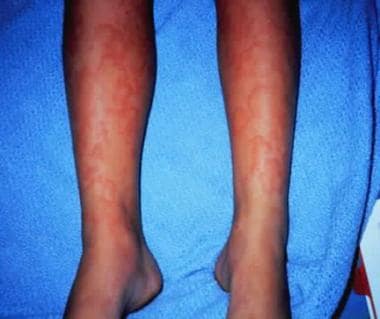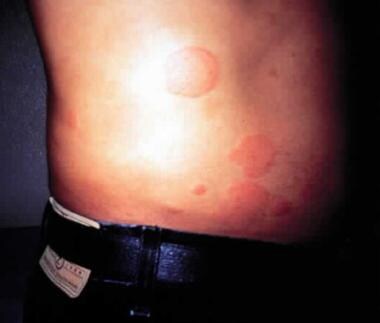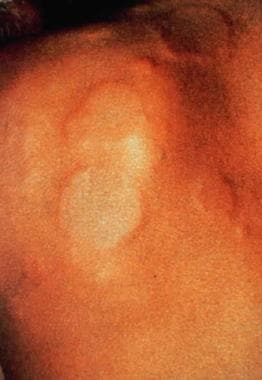Background
Urticaria (hives) is a vascular reaction of the skin marked by the transient appearance of smooth, slightly elevated papules or plaques (wheals) that are erythematous and that are often attended by severe pruritus. Individual lesions resolve without scarring in several hours. Most cases of urticaria are self-limited and of short duration; the eruption rarely lasts more than several days, it but may be recurrent over weeks. Chronic urticaria is defined as urticaria with recurrent episodes lasting longer than 6 weeks.
The development of urticaria is often an isolated event without systemic reaction. Rarely, it can be a prelude to the development of an anaphylactic reaction. (See Anatomy.)
If any features of anaphylaxis (eg, hypotension, respiratory distress, stridor, gastrointestinal distress, swallowing problems, joint swelling, joint pain) are present, immediate medical intervention should occur. (See Physical Examination.)
Acute urticaria may be, in a short time, associated with life-threatening angioedema and/or anaphylactic shock, although it usually presents as rapid-onset shock without urticaria or angioedema. (See Emergency Care and Complications.)
New-onset episodes of urticaria can be associated with identifiable causes, and the method of exposure (ie, direct contact, oral or intravenous [IV] routes) can be deduced by taking a careful history. (See Etiology.)
Acute urticaria is generally diagnosed based on a detailed patient history and physical examination. (See Clinical Presentation.)
Although clinically distinctive, urticaria may be confused with a variety of other dermatologic diseases that can be similar in appearance and are pruritic, including atopic dermatitis (eczema), maculopapular drug eruptions, contact dermatitis, insect bites, erythema multiforme, pityriasis rosea, and others. Usually, however, the experienced clinician is able to distinguish these conditions from urticaria because of the lesions’ hallmark appearance (see the images below), a lack of epidermal change, the intense pruritus, the presence of an advancing edge and a receding edge, the complete blanching of the lesions with pressure, and are the transient nature of the lesions.
(See Clinical Presentation.)
Urticaria associated with a drug reaction.
Urticaria developed after bites from an imported fire ant.
Local urticaria on a patient with latex allergy who was touched with a latex glove.
The major goal of treatment is to control the severity of acute urticarial lesions. Antihistamines are the primary agents used to treat urticaria. (See Treatment Strategies and Management.)



